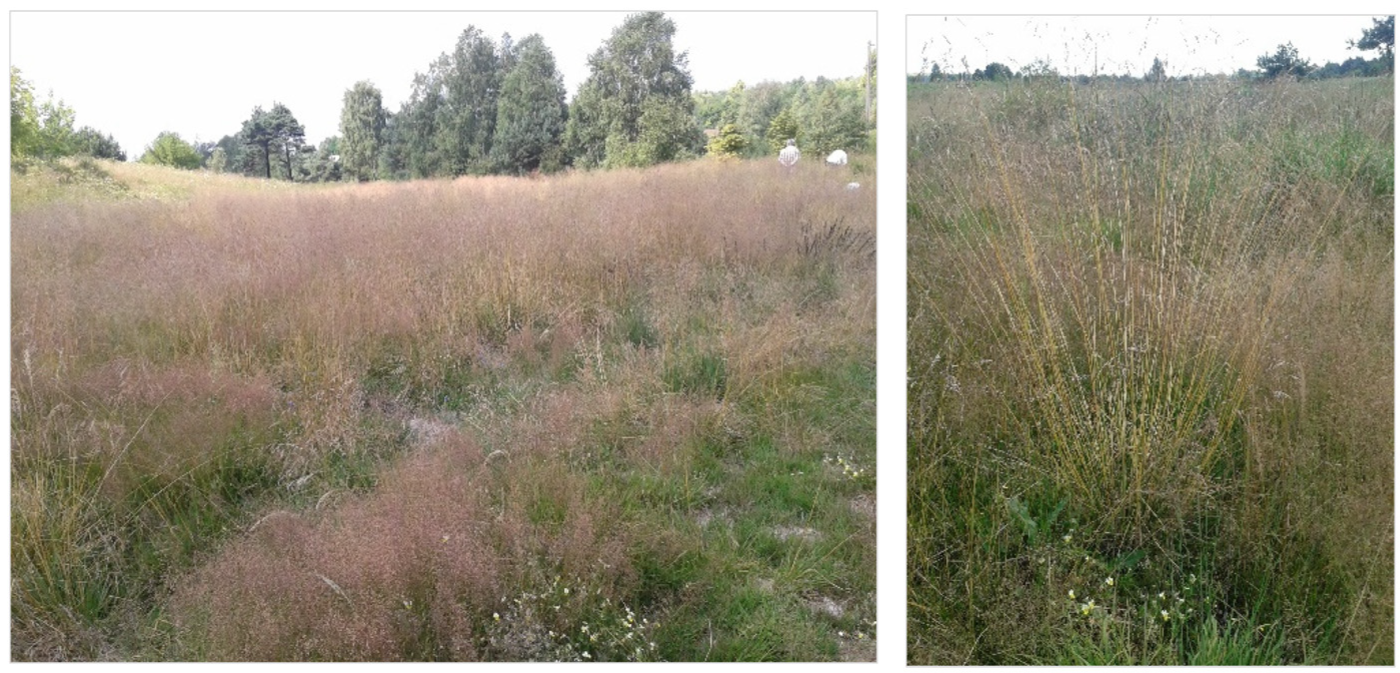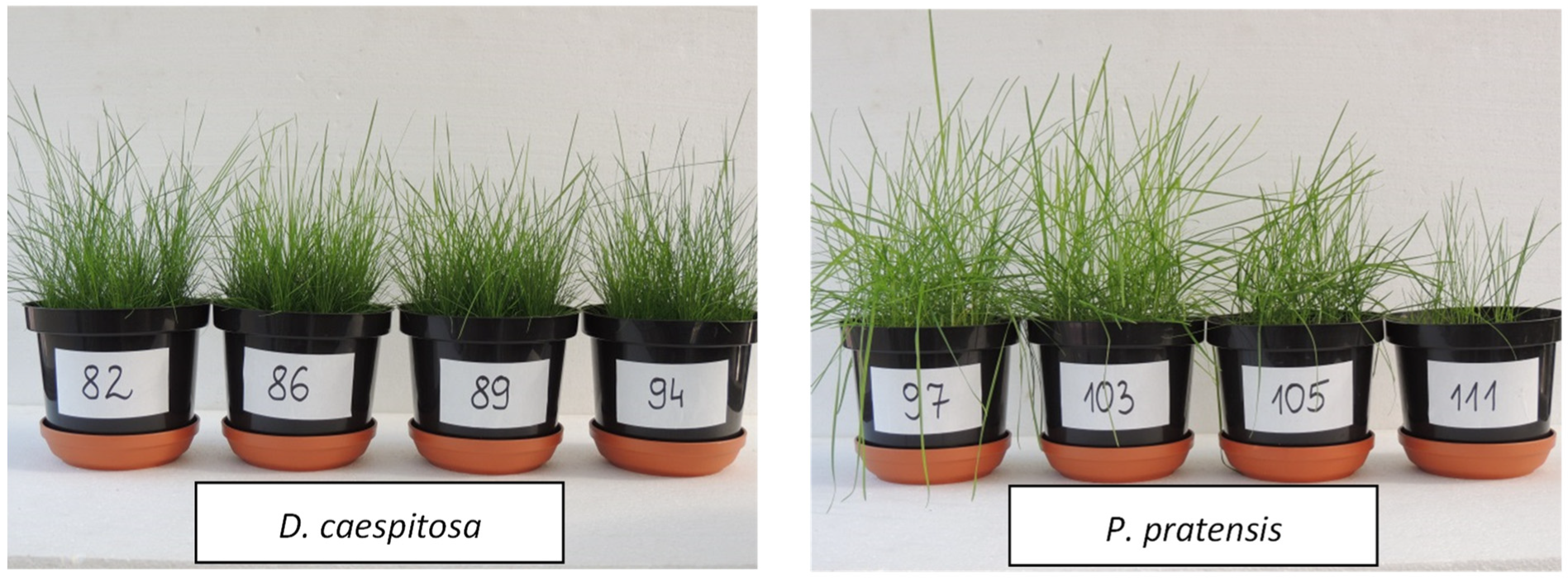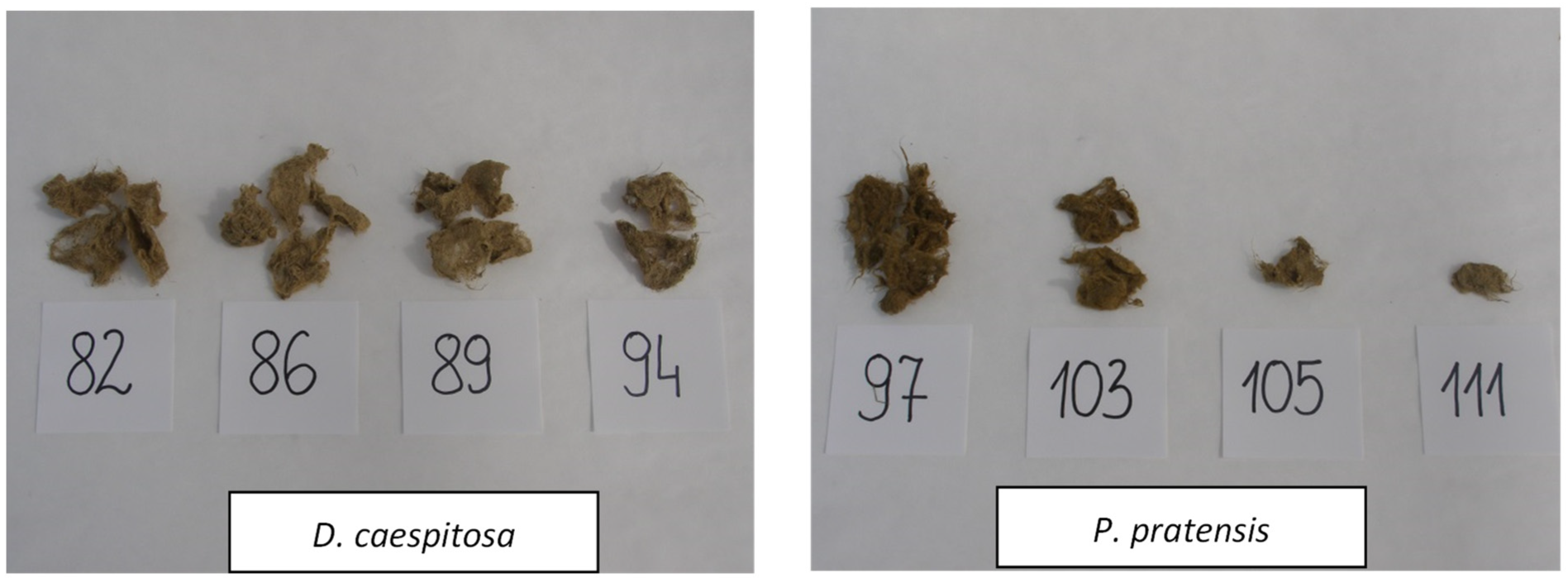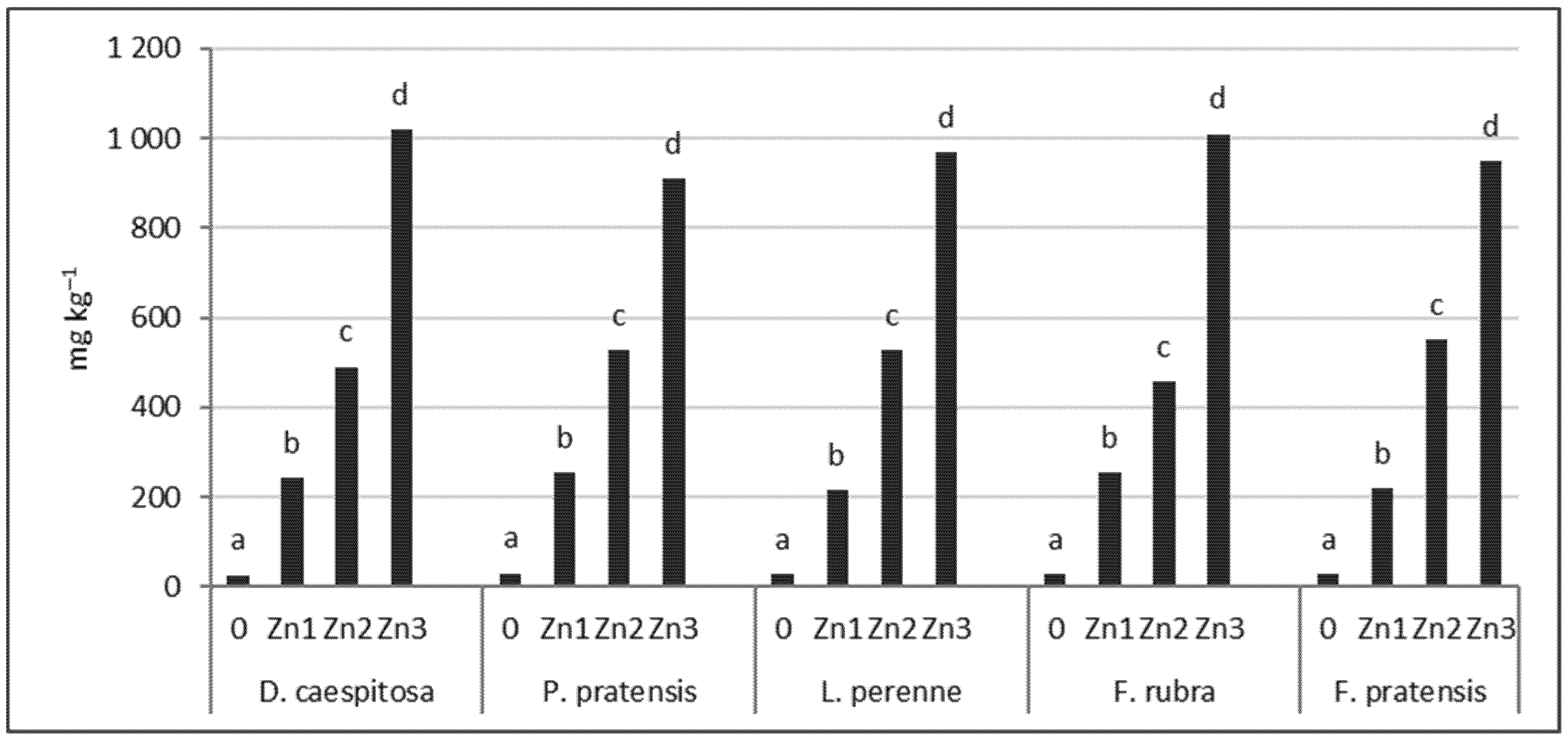The Phytoremediation Potential of Local Wild Grass Versus Cultivated Grass Species for Zinc-Contaminated Soil
Abstract
1. Introduction
2. Materials and Methods
2.1. Pot Experiments
2.2. Chemical Analyses
2.3. Calculation of the Tolerance Index and Bioaccumulation and Translocation Factors
2.4. Statistical Calculations
3. Results
3.1. Impact of Zinc on Grass Biomass
3.2. Zinc Content in Soil and Plants
3.3. Bioaccumulation (BF) and Translocation Factors (TF)
4. Discussion
5. Summary
Author Contributions
Funding
Data Availability Statement
Conflicts of Interest
References
- Pinto, A.P.; Mota, A.D.; De Varennes, A.; Pinto, F.C. Influence of organic matter on the uptake of cadmium, zinc, copper and iron by sorghum plants. Sci. Total Environ. 2004, 326, 239–247. [Google Scholar] [CrossRef] [PubMed]
- Liu, L.; Li, W.; Song, W.; Guo, M. Remediation techniques for heavy metal-contaminated soils: Principles and applicability. Sci. Total Environ. 2018, 633, 206–219. [Google Scholar] [CrossRef] [PubMed]
- Marques, A.P.G.C.; Rangel, A.O.S.S.; Castro, P.M.L. Remediation of heavy metal contaminated soils: Phytoremediation as a potentially promising clean-up technology. Crit. Rev. Environ. Sci. Technol. 2009, 39, 622–654. [Google Scholar] [CrossRef]
- Karczewska, A.; Lewińska, K.; Gałka, B. Arsenic extractability and uptake by velvetgrass Holcus lanatus and ryegrass Lolium perenne in variously treated soils polluted by tailing spills. J. Hazard. Mater. 2013, 262, 1014–1102. [Google Scholar] [CrossRef]
- Korzeniowska, J.; Stanislawska-Glubiak, E.; Igras, J. Applicability of energy crops for metal phytostabilization of soils moderately contaminated with copper, nickel and zinc. J. Food Agric. Environ. 2011, 9, 693–697. [Google Scholar]
- Korzeniowska, J.; Stanisławska-Glubiak, E. Phytoremediation potential of Phalaris arundinacea, Salix viminalis and Zea mays for nickel-contaminated soils. Int. J. Environ. Sci. Technol. 2019, 16, 1999–2008. [Google Scholar] [CrossRef]
- Stanislawska-Glubiak, E.; Korzeniowska, J.; Kocon, A. Effect of the reclamation of heavy metal-contaminated soil on growth of energy willow. Pol. J. Environ. Stud. 2012, 21, 187–192. [Google Scholar]
- Manara, A. Plant responses to heavy metal toxicity. In Plants and Heavy Metals; Springer: Dordrecht, The Netherlands, 2012; pp. 27–53. [Google Scholar]
- Pinto, A.P.; Simoes, I.; Mota, A.M. Cadmium impact on root exudates of sorghum and maize plants: A speciation study. J. Plant. Nutr. 2008, 31, 1746–1755. [Google Scholar] [CrossRef]
- Ghori, N.H.; Ghori, T.; Hayat, M.Q.; Imadi, S.R.; Gul, A.; Altay, V.; Ozturk, M. Heavy metal stress and responses in plants. Int. J. Environ. Sci. Tech. 2019, 16, 1807–1828. [Google Scholar] [CrossRef]
- Repka, V.; Fiala, R.; Čiamporová, M.; Pavlovkin, J. Effects of ZnCl2 on ROS generation, plasma membrane properties, and changes in protein expression in grapevine root explants. Biologia 2016, 71, 528–537. [Google Scholar] [CrossRef]
- Hossain, M.A.; Piyatida, P.; da Silva, J.A.T.; Fujita, M. Molecular mechanism of heavy metal toxicity and tolerance in plants: Central role of glutathione in detoxification of reactive oxygen species and methylglyoxal and in heavy metal chelation. J. Bot. 2012, 2012, 1–37. [Google Scholar] [CrossRef]
- Mirdehghan, S.H.; Ghotbi, F. Effects of Salicylic Acid, Jasmonic Acid, and Calcium Chloride on Reducing Chilling Injury of Pomegranate (Punica granatum L.). Fruit. J. Agric. Sci. Technol. 2014, 16, 163–173. [Google Scholar]
- Kushwaha, A.; Rani, R.; Kumar, S.; Gautam, A. Heavy metal detoxification and tolerance mechanisms in plants: Implications for phytoremediation. Environ. Rev. 2016, 24, 39–51. [Google Scholar] [CrossRef]
- He, L.; Su, R.; Chen, Y.; Zeng, P.; Du, L.; Cai, B.; Zhang, A.; Zhu, H. Integration of manganese accumulation, subcellular distribution, chemical forms, and physiological responses to understand manganese tolerance in Macleaya cordata. Environ. Sci. Pollut. Res. 2022, 29, 39017–39026. [Google Scholar] [CrossRef]
- Chaney, R.L. Zinc phytotoxicity. In Zinc in Soils and Plants; Springer: Dordrecht, The Netherlands, 1993; pp. 135–150. [Google Scholar]
- Korzeniowska, J.; Stanislawska-Glubiak, E. Differences in the concentration of micronutrients in young shoots of numerous cultivars of wheat, maize and oilseed rape. Agronomy 2022, 12, 2639. [Google Scholar] [CrossRef]
- Nagajyoti, P.C.; Lee, K.D.; Sreekanth, T.V.M. Heavy metals, occurrence and toxicity for plants: A review. Environ. Chem. Lett. 2010, 8, 199–216. [Google Scholar] [CrossRef]
- Abaga, N.O.Z.; Dousset, S.; Mbengue, S.; Munier-Lamy, C. Is vetiver grass of interest for the remediation of Cu and Cd to protect marketing gardens in Burkina Faso? Chemosphere 2014, 113, 2–47. [Google Scholar]
- Xia, H.P. Ecological rehabilitation and phytoremediation with four grasses in oil shale mined land. Chemosphere 2004, 54, 345–353. [Google Scholar] [CrossRef]
- Aibibu, N.; Liu, Y.; Zeng, G.; Wang, X.; Chen, B.; Song, H.; Xu, L. Cadmium accumulation in Vetiveria zizanioides and its effects on growth, physiological and biochemical characters. Bioresource Technol. 2010, 101, 6297–6303. [Google Scholar] [CrossRef]
- Xu, P.; Wang, Z. Physiological mechanism of hypertolerance of cadmium in Kentucky bluegrass and tall fescue: Chemical forms and tissue distribution. Environ. Exp. Bot. 2013, 96, 35–42. [Google Scholar] [CrossRef]
- Zhang, S.; Lin, H.; Deng, L.; Gong, G.; Jia, Y.; Xu, X.; Li, T.; Li, Y.; Chen, H. Cadmium tolerance and accumulation characteristic Siegesbeckia orientalis L. Ecol. Eng. 2013, 51, 133–139. [Google Scholar] [CrossRef]
- Maric, M.; Antonijevic, M.; Alagic, S. The investigation of the possibility for using some wild and cultivated plants as hyperaccumulators of heavy metals from contaminated soil. Environ. Sci. Pollut. Res. 2013, 20, 1181–1188. [Google Scholar] [CrossRef] [PubMed]
- Christou, A.; Theologides, C.P.; Costa, C.; Kalavrouziotis, J.K.; Varnavas, S.P. Assessment of toxic heavy metals concentrations in soils and wild and cultivated plant species in Limni abandoned copper mining site, Cyprus. J. Geoch. Explor. 2017, 178, 16–22. [Google Scholar] [CrossRef]
- PN-EN ISO/IEC 17025:2018-02; General Requirements for the Competence of Testing and Calibration Laboratories. Polish Committee for Standardization: Warsaw, Poland, 2018. (In Polish)
- PN-ISO 11047:2001; Soil Quality—Determination of Cadmium, Chromium, Cobalt, Copper, Lead, Manganese, Nickel and Zinc in Aqua Regia Extracts of Soil—Flame and Electrothermal Atomic Absorption Spectrometric Methods. Polish Committee for Standardization: Warsaw, Poland, 2013. (In Polish)
- PN-ISO 14235:2003; Soil Quality—Determination of Organic Carbon in Soil by Sulfochromic Oxidation. Polish Committee for Standardization: Warsaw, Poland, 2003. (In Polish)
- PN-EN ISO 10390:2022-09; Soil, Treated Biowaste and Sludge—Determination of pH (ISO 10390:2021). Polish Committee for Standardization: Warsaw, Poland, 2022. (In Polish)
- PN-R-04033:1998; Soil and Mineral Soil Materials—Particle Size Distribution on Soil Classes. Polish Committee for Standardization: Warsaw, Poland, 1998. (In Polish)
- PN-R-04023:1996; Agrochemical Soil Analyse–Determination of Assimilated Phosphorus Contents. Committee for Standardization, Warsaw, Poland, 1996. (In Polish)
- PN-R-04022:1996; Agrochemical Soil Analyse—Determination of Assimilated Potassium Content. Committee for Standardization: Warsaw, Poland, 1996. (In Polish)
- PN-R-04020:1994; Agrochemical Soil Analyse—Determination of Assimilated Magnesium Content. Committee for Standardization: Warsaw, Poland, 1994. (In Polish)
- PN-R-04014:1991; Agrochemical Plant Analyse—Methods of Mineralization of Plant Material for Determination Macro- and Microelements. Polish Committee for Standardization: Warsaw, Poland, 1991. (In Polish)
- Wilkins, D.A. The measurement of tolerance to edaphic factors by means of root growth. New Phytol. 1978, 80, 623–633. [Google Scholar] [CrossRef]
- Melo, E.E.C.; Costa, E.T.S.; Guilherme, L.R.G.; Faquin, V.; Nascimento, C.W.A. Accumulation of arsenic and nutrients by castor bean plants grown on an As-enriched nutrient solution. J. Hazard. Mater. 2009, 168, 479–483. [Google Scholar] [CrossRef] [PubMed]
- Compton, H.R.; Prince, G.R.; Fredericks, S.C.; Gussman, C.D. Phytoremediation of dissolved phase organic compounds: Optimal site considerations relative to field case studies. Remediation 2003, 13, 21–37. [Google Scholar] [CrossRef]
- Favas, P.J.; Pratas, J.; Varun, M.; D’Souza, R.; Paul, M.S. Phytoremediation of soils contaminated with metals and metalloids at mining areas: Potential of native flora. In Environmental Risk Assessment of Soil Contamination; Maria, C., Hernandez, S., Eds.; IntechOpen: Shanghai, China, 2014. [Google Scholar]
- Fu, S.; Wei, C.; Xiao, Y.; Li, L.; Wu, D. Heavy Metals Uptake and Transport by Native Wild Plants: Implications for Phytoremediation and Restoration. Environ. Earth Sci. 2019, 78, 103. [Google Scholar] [CrossRef]
- Tordoff, G.M.; Baker, A.J.M.; Willis, A.J. Current approaches to the revegetation and reclamation of metalliferous mine wastes. Chemosphere 2000, 41, 219–228. [Google Scholar] [CrossRef]
- Heckenroth, A.; Rabier, J.; Dutoit, T.; Torre, F.; Prudent, P.; Laont-Schwob, I. Selection of native plants with phytoremediation potential for highly contaminated Mediterranean soil restoration: Tools for a non-destructive and integrative approach. J. Environ. Manag. 2016, 183, 850–863. [Google Scholar] [CrossRef]
- Lamb, D.T.; Ming, H.; Megharaj, M.; Naidu, R. Relative tolerance of a range of Australian native plant species and lettuce to copper, zinc, cadmium, and lead. Arch. Environ. Contam. Toxicol. 2010, 59, 424–432. [Google Scholar] [CrossRef]
- Atabayeva, S. Heavy metals accumulation ability of wild grass species from industrial areas of Kazakhstan. In Phytoremediation; Ansari, S.S., Gill, R., Gill, G.R., Lanza, L., Newman, A., Eds.; Springer: Berlin/Heidelberg, Germany, 2016; pp. 157–208. [Google Scholar]
- De Conti, L.; Marques, A.C.; Ceretta, C.A.; Tarouco, C.P.; Nicoloso, F.T.; Ferreira, P.A.; Tiecher, T.L.; Tassinari, A.; Bicalho da Silva, I.C.; Brunetto, G. Tolerance and phytoremediation potential of grass species native to South American grasslands to copper-contaminated soils. Int. J. Phytoremediat. 2021, 23, 726–735. [Google Scholar] [CrossRef] [PubMed]
- Elekes, C.C. Eco-technological solutions for the remediation of polluted soil and heavy metal recovery. In Environmental Risk Assessment of Soil Contamination; IHernández-Soriano, M.C., Ed.; TechOpen: London, UK, 2014; pp. 309–335. [Google Scholar]
- Guterres, J.; Rossato, L.; Doley, D.; Pudmenzky, A.; Bee, C.; Cobena, V. Assessing germination characteristics of Australian native plant species in metal/metalloid solution. J. Hazard. Mater. 2019, 364, 173–181. [Google Scholar] [CrossRef] [PubMed]
- Malik, R.N.; Husain, S.Z.; Nazir, I. Heavy metal contamination and accumulation in soil and wild plant species from industrial area of Islamabad, Pakistan. Pak. J. Bot. 2010, 42, 291–301. [Google Scholar]
- Cheraghi, M.; Lorestani, B.; Khorasani, N.; Yousef, N.; Karami, M. Findings on the phytoextraction and phytostabilization of soils contaminated with heavy metals. Biol. Trace Elem. Res. 2011, 144, 1133–1141. [Google Scholar] [CrossRef]
- Roccotiello, E.; Manfredi, A.; Drava, G.; Minganti, V.; Mariotti, M.; Berta, G.; Cornara, L. Zinc tolerance and accumulation in the ferns Polypodium cambricum L. and Pteris vittata L. Ecotoxicol. Environ. Saf. 2010, 73, 1264–1271. [Google Scholar] [CrossRef]
- Su, R.; Ou, Q.; Wang, H.; Luo, Y.; Dai, X.; Wang, Y.; Chen, Y.; Shi, L. Comparison of phytoremediation potential of Nerium indicum with inorganic modifier calcium carbonate and organic modifier mushroom residue to lead-zinc tailings. Int. J. Environ. Res. Public Health 2022, 19, 10353. [Google Scholar] [CrossRef]
- Sharma, A.; Sidhu, G.P.; Araniti, F.; Bali, A.S.; Shahzad, B.; Tripathi, D.K.; Brestic, M.; Skalicky, M.; Landi, M. The role of salicylic acid in plants exposed to heavy metals. Molecules 2020, 25, 540. [Google Scholar] [CrossRef]
- Stanislawska-Glubiak, E.; Korzeniowska, J. Effect of salicylic acid foliar application on two wheat cultivars grown under zinc stress. Agronomy 2022, 12, 60. [Google Scholar] [CrossRef]







| Soil Feature | Value | |
|---|---|---|
| pH in KCl | 5.4 | |
| Sand | % | 73.9 |
| Silt | 23.5 | |
| Clay | 2.6 | |
| TOC | mg-kg−1 | 0.66 |
| P2O5 | 237 1 | |
| K2O | 159 1 | |
| Mg | 65 2 | |
| Zn | 28 3 | |
| Sample No. | Cu | Pb | Zn | Cd |
|---|---|---|---|---|
| mg kg−1 in Aqua Regia | ||||
| 1 | 5.5 | 114 | 553 | 8.0 |
| 2 | 8.0 | 161 | 809 | 13.2 |
| 3 | 4.0 | 293 | 766 | 7.1 |
| 4 | 5.5 | 376 | 854 | 10.9 |
| Mean | 5.8 | 236 | 745 | 9.8 |
| Grass | Shoots | Roots | Whole Plant |
|---|---|---|---|
| % | |||
| D. caespitosa | 68 | 79 | 70 |
| P. pratensis | 42 | 43 | 43 |
| L. perenne | 69 | 39 | 60 |
| F. rubra | 58 | 48 | 55 |
| F. pratensis | 49 | 47 | 48 |
| Grass | Zn Level | BFshoot | BFroot | TF |
|---|---|---|---|---|
| D. caespitosa | Zn1 | 4.3 | 15.5 | 0.28 |
| Zn2 | 4.1 | 11.0 | 0.37 | |
| Zn3 | 2.0 | 6.8 | 0.29 | |
| Mean | 3.5 | 11.1 | 0.31 | |
| P. pratensis | Zn1 | 4.9 | 13.1 | 0.37 |
| Zn2 | 4.5 | 13.3 | 0.34 | |
| Zn3 | 3.4 | 8.8 | 0.39 | |
| Mean | 4.3 | 11.7 | 0.36 | |
| L. perenne | Zn1 | 8.1 | 17.6 | 0.46 |
| Zn2 | 5.0 | 11.2 | 0.45 | |
| Zn3 | 3.0 | 7.1 | 0.42 | |
| Mean | 5.4 | 12.0 | 0.45 | |
| F. rubra | Zn1 | 5.6 | 14.3 | 0.39 |
| Zn2 | 5.1 | 11.0 | 0.46 | |
| Zn3 | 3.4 | 6.9 | 0.49 | |
| Mean | 4.7 | 10.7 | 0.44 | |
| F. pratensis | Zn1 | 8.3 | 17.9 | 0.46 |
| Zn2 | 5.2 | 12.2 | 0.43 | |
| Zn3 | 4.1 | 9.7 | 0.42 | |
| Mean | 5.9 | 13.3 | 0.44 |
Disclaimer/Publisher’s Note: The statements, opinions and data contained in all publications are solely those of the individual author(s) and contributor(s) and not of MDPI and/or the editor(s). MDPI and/or the editor(s) disclaim responsibility for any injury to people or property resulting from any ideas, methods, instructions or products referred to in the content. |
© 2023 by the authors. Licensee MDPI, Basel, Switzerland. This article is an open access article distributed under the terms and conditions of the Creative Commons Attribution (CC BY) license (https://creativecommons.org/licenses/by/4.0/).
Share and Cite
Korzeniowska, J.; Stanislawska-Glubiak, E. The Phytoremediation Potential of Local Wild Grass Versus Cultivated Grass Species for Zinc-Contaminated Soil. Agronomy 2023, 13, 160. https://doi.org/10.3390/agronomy13010160
Korzeniowska J, Stanislawska-Glubiak E. The Phytoremediation Potential of Local Wild Grass Versus Cultivated Grass Species for Zinc-Contaminated Soil. Agronomy. 2023; 13(1):160. https://doi.org/10.3390/agronomy13010160
Chicago/Turabian StyleKorzeniowska, Jolanta, and Ewa Stanislawska-Glubiak. 2023. "The Phytoremediation Potential of Local Wild Grass Versus Cultivated Grass Species for Zinc-Contaminated Soil" Agronomy 13, no. 1: 160. https://doi.org/10.3390/agronomy13010160
APA StyleKorzeniowska, J., & Stanislawska-Glubiak, E. (2023). The Phytoremediation Potential of Local Wild Grass Versus Cultivated Grass Species for Zinc-Contaminated Soil. Agronomy, 13(1), 160. https://doi.org/10.3390/agronomy13010160






